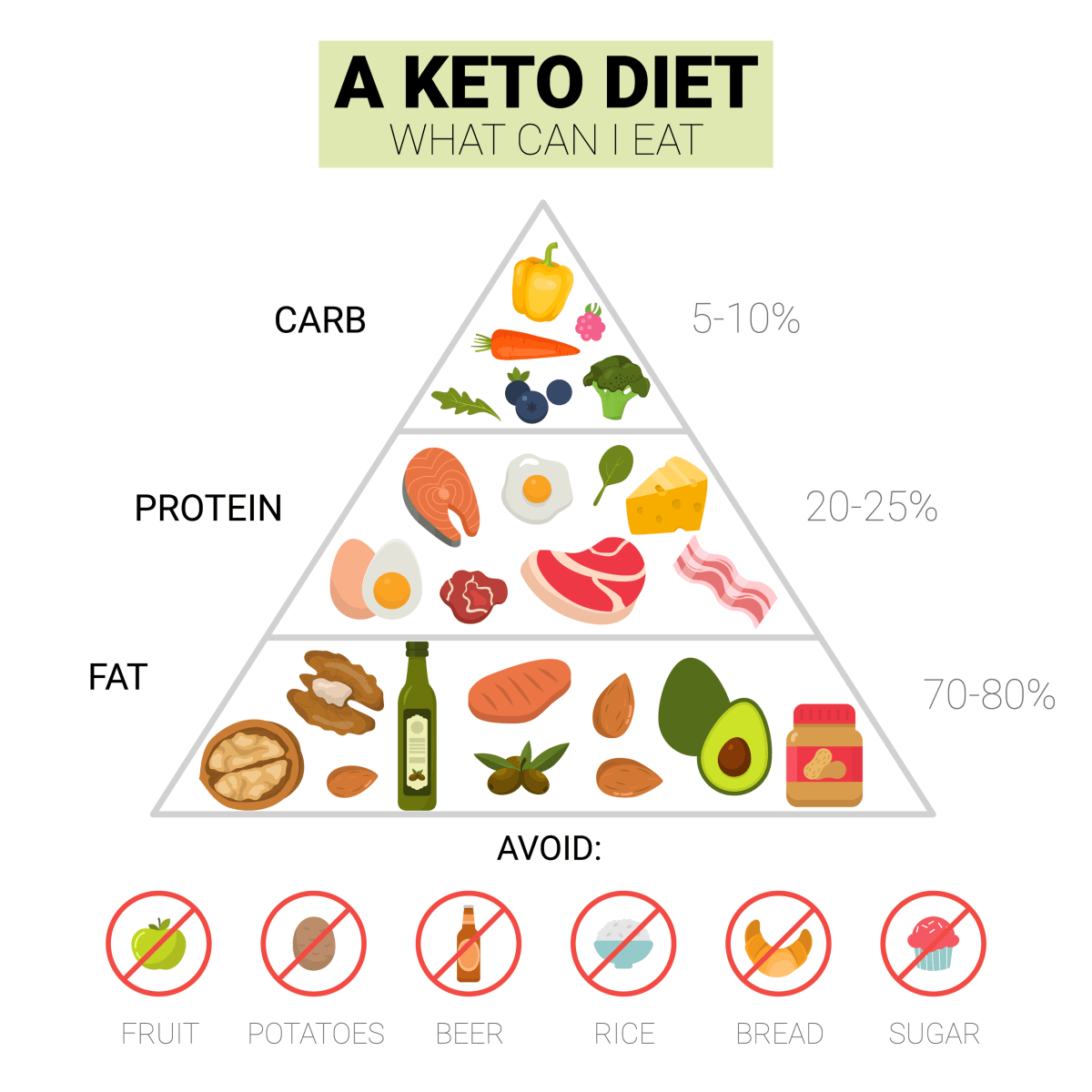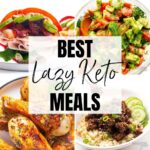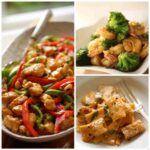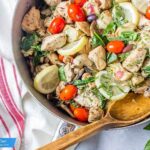Embark on a culinary journey with “The Best Keto Recipes for a High-Protein Diet,” a comprehensive guide designed to tantalize your taste buds while fueling your body with the power of protein and healthy fats. This collection isn’t just about following a diet; it’s about embracing a lifestyle change that celebrates delicious, satisfying meals while adhering to the principles of ketosis. Prepare to discover a world of flavor and variety, from vibrant breakfast bowls bursting with color and texture to hearty dinners that will leave you feeling energized and satisfied. We’ll explore diverse recipes, practical meal-prep strategies, and the essential science behind macronutrient balancing for optimal keto success.
Through detailed recipes, stunning visuals, and expert tips, you’ll master the art of high-protein keto cooking. Learn how to select protein-rich ingredients, incorporate them effectively into your meals, and manage your macros to achieve your dietary goals. Whether you’re a seasoned keto enthusiast or a curious beginner, this guide provides the tools and inspiration to transform your relationship with food and achieve lasting health and wellness.
High-Protein Keto Breakfast Recipes
Kickstarting your day with a high-protein keto breakfast is crucial for maintaining ketosis and fueling your body efficiently. These recipes provide a delicious and satisfying start to your day, ensuring you stay on track with your dietary goals. Each recipe is designed to be both quick to prepare and packed with the nutrients you need.
High-Protein Keto Breakfast Recipes
The following table details three high-protein keto breakfast recipes, including their ingredients, preparation steps, and estimated nutritional information. Remember that nutritional information is an estimate and can vary depending on specific ingredients used.
| Name | Ingredients | Instructions | Nutritional Information (Estimated) |
|---|---|---|---|
| Keto Egg & Cheese Cups | 4 large eggs, 1/4 cup shredded cheddar cheese, 1/4 cup chopped bacon or sausage (cooked), 1 tablespoon cream cheese, salt and pepper to taste | 1. Preheat oven to 350°F (175°C). 2. Grease a muffin tin. 3. Whisk eggs, salt, and pepper. 4. Divide cheese and meat evenly among muffin cups. 5. Pour egg mixture over cheese and meat. 6. Bake for 15-20 minutes, or until set. 7. Let cool slightly before removing from muffin tin. | Protein: 20g, Fat: 25g, Net Carbs: 2g (per serving, assuming 4 servings) |
| Chia Seed Pudding with Berries and Nuts | 1/4 cup chia seeds, 1 cup unsweetened almond milk, 1/4 cup heavy cream, 1/4 cup mixed berries (strawberries, raspberries, blueberries), 1 tablespoon chopped almonds, sweetener to taste (e.g., stevia or erythritol) | 1. Combine chia seeds, almond milk, heavy cream, and sweetener in a jar or container. 2. Stir well and refrigerate overnight (or for at least 2 hours). 3. In the morning, top with berries and almonds. | Protein: 10g, Fat: 20g, Net Carbs: 5g (per serving) |
| Keto Avocado Toast with Smoked Salmon | 1 slice of keto bread (e.g., almond flour bread), 1/2 avocado, mashed, 2 ounces smoked salmon, salt and pepper to taste, optional: everything bagel seasoning | 1. Toast the keto bread. 2. Spread mashed avocado on toast. 3. Top with smoked salmon. 4. Season with salt, pepper, and everything bagel seasoning (if using). | Protein: 15g, Fat: 28g, Net Carbs: 5g (per serving, depending on bread type) |
High-Protein Keto Breakfast Image Description
The image depicts a vibrant and appetizing high-protein keto breakfast. Natural light streams in from the left, illuminating the scene and casting soft shadows. The composition is carefully arranged, with a rustic wooden background enhancing the natural feel. In the foreground, a creamy, golden-yellow chia seed pudding is nestled in a small bowl. The pudding is speckled with dark-red raspberries and bright-blue blueberries, contrasting beautifully with the pale color of the pudding. A scattering of chopped almonds adds a textural element and a hint of brown. Behind the pudding, a portion of keto-friendly avocado toast is visible, its pale green avocado contrasting with the rich, dark orange of the smoked salmon. The lighting emphasizes the textures of the food—the smooth creaminess of the pudding, the slight roughness of the almonds, the delicate flakes of salmon, and the soft texture of the avocado. The overall effect is one of warmth, inviting the viewer to indulge in a healthy and delicious keto breakfast.
Benefits of High-Protein Keto Breakfast Recipes
These high-protein keto breakfast recipes offer several key benefits. The high protein content helps to promote satiety, reducing cravings and preventing overeating throughout the day. This is particularly important on a ketogenic diet, where maintaining a low carbohydrate intake is essential for staying in ketosis. The recipes are also designed to be rich in healthy fats, which provide sustained energy and support various bodily functions. The combination of protein and healthy fats helps to stabilize blood sugar levels, preventing energy crashes and mood swings often associated with low-carb diets. Moreover, the recipes are versatile and can be easily adapted to personal preferences and dietary needs, ensuring a delicious and enjoyable start to every day on your keto journey. For instance, the Keto Egg & Cheese Cups recipe can be modified with different cheeses or vegetables, while the Chia Seed Pudding can be customized with various types of nuts and seeds.
High-Protein Keto Lunch & Dinner Recipes
Embark on a culinary journey with these flavorful and satisfying high-protein keto lunch and dinner recipes, designed to keep you energized and in ketosis. Each recipe is meticulously crafted to provide a balanced blend of healthy fats and protein, minimizing carbohydrates for optimal results. These recipes offer a delightful variety of tastes and textures, proving that a ketogenic diet doesn’t mean sacrificing culinary enjoyment.
Five High-Protein Keto Lunch and Dinner Recipes
The following recipes showcase the versatility of a high-protein ketogenic diet, offering diverse flavor profiles and cooking methods. Each recipe is designed to be both delicious and easily adaptable to your individual preferences.
- Spicy Shrimp and Avocado Salad:
- Combine 1 cup cooked shrimp, ½ avocado (diced), ¼ cup chopped red onion, and 2 tablespoons chopped cilantro.
- Whisk together 2 tablespoons olive oil, 1 tablespoon lime juice, ½ teaspoon chili powder, and a pinch of salt and pepper.
- Pour dressing over salad and toss gently. Serve immediately.
- Creamy Pesto Chicken with Zucchini Noodles:
- Cook 2 chicken breasts (about 6oz total) until fully cooked. Shred or slice the chicken.
- Spiralize 2 medium zucchini into noodles.
- Combine shredded chicken with ¼ cup pesto, 2 tablespoons cream cheese, and a pinch of salt and pepper.
- Toss zucchini noodles with the chicken mixture and serve.
- Steak with Roasted Asparagus and Cauliflower Mash:
- Season a 6-ounce steak with salt, pepper, and garlic powder.
- Sear the steak in a hot pan with olive oil until cooked to your liking.
- Roast 1 bunch of asparagus with olive oil, salt, and pepper at 400°F (200°C) for 15-20 minutes.
- Steam 1 head of cauliflower until tender, then mash with 2 tablespoons of butter and a splash of cream (or heavy cream substitute).
- Serve steak with roasted asparagus and cauliflower mash.
- Salmon with Roasted Broccoli and Almond Butter Sauce:
- Season a 6-ounce salmon fillet with salt, pepper, and dill.
- Bake salmon at 400°F (200°C) for 12-15 minutes, or until cooked through.
- Roast 1 head of broccoli florets with olive oil, salt, and pepper at 400°F (200°C) for 15-20 minutes.
- Whisk together 2 tablespoons almond butter, 1 tablespoon olive oil, 1 tablespoon lemon juice, and a pinch of salt.
- Serve salmon with roasted broccoli and almond butter sauce.
- Ground Beef and Cabbage Stir-Fry:
- Brown 1 pound of ground beef in a large skillet over medium-high heat.
- Add 1 medium head of cabbage (shredded), 1 chopped onion, and 2 cloves of minced garlic.
- Stir-fry until cabbage is tender-crisp.
- Season with soy sauce (low sodium), ginger, and a pinch of red pepper flakes.
Tips for Maximizing Protein Intake in Keto Lunches and Dinners
Strategic protein selection and incorporation are crucial for achieving optimal results on a high-protein ketogenic diet. The following tips highlight effective strategies for maximizing protein intake while staying within your macronutrient targets.
- Prioritize high-protein sources: Lean meats (chicken breast, turkey, sirloin), fish (salmon, tuna, cod), eggs, and Greek yogurt are excellent choices. These foods offer a high protein-to-carbohydrate ratio.
- Incorporate protein at every meal: Don’t just rely on a large protein source at dinner. Include smaller portions of protein in your lunch and snacks to maintain consistent blood sugar levels and prevent hunger pangs.
- Utilize protein-rich add-ins: Boost the protein content of your meals with additions like chia seeds, hemp seeds, or protein powder (whey or casein) in smoothies or sauces.
Nutritional Comparison of Recipes
A comparative analysis of the nutritional profiles of the five recipes reveals a range of macronutrient compositions. Precise values will vary based on specific ingredients and portion sizes. However, these estimations offer a general understanding of their nutritional characteristics. Note: These are approximate values and can vary depending on specific ingredients and portion sizes.
| Recipe | Approximate Protein (grams) | Approximate Fat (grams) | Approximate Carbohydrates (grams) |
|---|---|---|---|
| Spicy Shrimp and Avocado Salad | 30 | 35 | 5 |
| Creamy Pesto Chicken with Zucchini Noodles | 40 | 30 | 5 |
| Steak with Roasted Asparagus and Cauliflower Mash | 45 | 45 | 5 |
| Salmon with Roasted Broccoli and Almond Butter Sauce | 40 | 40 | 5 |
| Ground Beef and Cabbage Stir-Fry | 50 | 35 | 10 |
High-Protein Keto Snack Ideas

Maintaining ketosis while satisfying hunger pangs requires strategic snacking. High-protein, keto-friendly snacks help curb cravings and keep energy levels stable throughout the day, preventing the dreaded keto flu and supporting your high-protein goals. These snacks focus on providing a balance of healthy fats and protein, crucial for sustained satiety on a ketogenic diet.
High-Protein Keto Snack Recipe Table
The following table Artikels five quick and easy high-protein keto snack recipes, detailing their ingredients, preparation, and approximate caloric information. Remember that caloric values are estimates and can vary based on specific ingredients used.
| Snack Name | Ingredients | Preparation Steps | Caloric Information (Approximate) |
|---|---|---|---|
| Avocado and Hard-Boiled Egg Salad | 1 ripe avocado, mashed; 2 hard-boiled eggs, chopped; 1 tablespoon mayonnaise (or dairy-free alternative); salt and pepper to taste | Combine all ingredients in a bowl and mix well. Serve immediately or chill for later. | ~300 calories |
| Cheese and Meat Roll-Ups | 4 slices deli turkey or ham; 4 slices cheddar cheese; 2 tablespoons cream cheese (optional) | Spread cream cheese (if using) on each slice of meat. Top with cheese and roll tightly. | ~150-200 calories (per roll-up) |
| Macadamia Nut and Celery Sticks | 1 cup macadamia nuts; 4 celery sticks | Wash and cut celery into sticks. Serve with macadamia nuts alongside. | ~250 calories |
| String Cheese with Olives | 2 sticks string cheese; 10-12 olives (green or kalamata) | Enjoy the string cheese and olives as is. | ~200 calories |
| Keto “Nice” Cream | 1 frozen banana (pre-sliced and frozen); 1/4 cup heavy cream; 1 tablespoon peanut butter (or other nut butter); 1 scoop protein powder (vanilla or unflavored) | Blend all ingredients in a food processor until smooth and creamy. | ~350 calories (depending on protein powder) |
The Importance of Healthy Fats and Protein for Satiety
Healthy fats and protein are fundamental to maintaining satiety on a ketogenic diet. Protein contributes to feelings of fullness by promoting the release of satiety hormones. Fats, particularly healthy fats like those found in avocados, macadamia nuts, and heavy cream (in the Keto “Nice” Cream), provide sustained energy and help slow down digestion, preventing rapid blood sugar spikes and subsequent crashes. For instance, the avocado in the Avocado and Hard-Boiled Egg Salad provides healthy monounsaturated fats, contributing to a feeling of fullness that lasts longer than a carbohydrate-rich snack. The protein from the eggs further enhances this satiating effect.
Adapting Keto Snack Recipes for Dietary Restrictions
Adapting these recipes to accommodate dietary restrictions is straightforward. For nut allergies, substitute macadamia nuts in the Macadamia Nut and Celery Sticks with sunflower seeds or pumpkin seeds. For dairy-free options, use dairy-free alternatives for mayonnaise and cream cheese in the Avocado and Hard-Boiled Egg Salad and Cheese and Meat Roll-Ups. Consider using coconut cream instead of heavy cream in the Keto “Nice” Cream. Always check ingredient labels to ensure products are keto-friendly and meet your specific dietary needs.
Mastering a high-protein keto diet doesn’t have to be a daunting task. With “The Best Keto Recipes for a High-Protein Diet,” you’ll discover that healthy eating can be both delicious and surprisingly simple. From the vibrant colors of perfectly balanced breakfast plates to the satisfying aromas of flavorful dinners, this guide empowers you to create a personalized keto experience that fits your lifestyle and preferences. So, embark on this culinary adventure, experiment with new flavors, and savor the journey towards a healthier, more energetic you. Remember, sustainable success in any diet comes from finding joy in the process, and this guide is here to make that journey enjoyable and rewarding.
Essential Questionnaire
Can I follow a high-protein keto diet if I have kidney problems?
Consult your doctor before starting any high-protein diet, especially if you have pre-existing kidney conditions. High protein intake can strain the kidneys.
How much water should I drink on a high-protein keto diet?
Stay well-hydrated by drinking plenty of water throughout the day. Protein metabolism can increase water loss.
What are some common side effects of starting a keto diet?
Common side effects include keto flu (headaches, fatigue, nausea), constipation, and “keto breath.” These usually subside as your body adapts.
Are there any supplements I should consider while on a keto diet?
Consult your doctor or a registered dietitian before taking any supplements. Some people find electrolytes helpful to combat keto flu.


